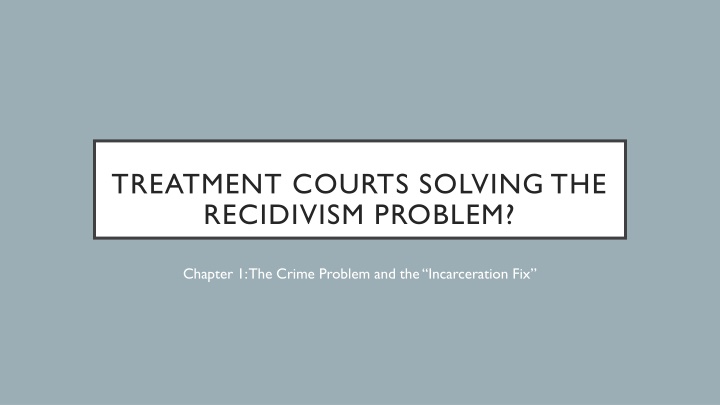
Solving Recidivism Problem with Treatment Courts
Explore the complexities of crime, incarceration fix, and the impact of the Get Tough approach in the criminal justice system. Learn about the models of the criminal justice system and the sources of crime data like UCR and NCVS. Understand the costs of crime on victims and society.
Download Presentation

Please find below an Image/Link to download the presentation.
The content on the website is provided AS IS for your information and personal use only. It may not be sold, licensed, or shared on other websites without obtaining consent from the author. If you encounter any issues during the download, it is possible that the publisher has removed the file from their server.
You are allowed to download the files provided on this website for personal or commercial use, subject to the condition that they are used lawfully. All files are the property of their respective owners.
The content on the website is provided AS IS for your information and personal use only. It may not be sold, licensed, or shared on other websites without obtaining consent from the author.
E N D
Presentation Transcript
TREATMENT COURTS SOLVING THE RECIDIVISM PROBLEM? Chapter 1: The Crime Problem and the Incarceration Fix
INTRODUCTION Crime is represented across all media Most everyone has an opinion, perspective, or fear of crime Many in the public are unaware of official crime statistics
INTRODUCTION The U.S. has one of the highest crime rates of high income nations Crime has dropped in the U.S. since the peak in the 1990s One of the main responses to crime was the use of incarceration
PACKERS 2 MODELS OF THE CRIMINAL JUSTICE SYSTEM Due Process focuses on defendants rights, sees the criminal justice system as an obstacle course to protect these rights Crime Control- focuses on protecting the public from criminals The foundation of the Get Tough approach on crime
THE GET TOUGH APPROACH The Get Tough approach has dominated criminal justice policy since the 1970s It involves increased use of law enforcement and incarceration The dominance of this approach has led to expansion of jails and prisons across the U.S.
SOURCES OF CRIME DATA: UCR Uniform Crime Report (UCR) largely relied on for official crime statistics Administered yearly by the FBI Gathers information on 2 types of crime: (1) Part 1 Crimes more serious crimes (e.g., murder, forcible rape, arson) (2) Part 2 Crimes - less serious (e.g., embezzlement, vagrancy)
SOURCE OF CRIME DATA: NCVS National Crime Victims Survey (NCVS) Used to address the Dark Figure of under-reported crime Conducted by the Bureau of Justice Statistics Collected from a random sample of households across the U.S. Gathers information on demographics of respondents and offenders Does not collect information on homicide
COSTS OF CRIME: VICTIMS Material - lost and stolen goods Not all may be covered by homeowners or renters insurance Costs of medical care for victims, lost wages Non-material include loss of quality of life for victims mental health issues as result of victimization
COST OF CRIME: THE CRIMINAL JUSTICE SYSTEM 2017 data found over $300 billion was spent on local, state and federal level in the criminal justice system Incarceration is especially costly with a 42% increase from $63 billion in 1997 to $89 billion in 2017
MASS INCARCERATION Rooted in the findings of Martinson s (1974) report, Nothing Works Influenced by the crime boom of the 1970s The public s increase fear of crime All of these led to the use of mass incarceration of offenders as part of the get tough approach on crime
MASS INCARCERATION: CORE CONCEPTS 2 Key Concepts Incapacitation - if mass incarceration is effective, it is because more offenders are behind bars than on the street Deterrence - if mass incarceration is effective, it is because potential offenders are afraid of being incarcerated
KEY CONCEPTUAL ISSUES OF INCAPACITATION A small number of offenders commit the bulk of crimes Funnel Effect a large number of offenses don t find their way into the criminal justice system Aging out- since more and more offenders are incarceration, and for longer periods of time, the typical inmate is now older than in the past
MASS INCARCERATION: COSTS TO FAMILIES & COMMUNITIES Loss of parents who are incarcerated for children is especially concerning, may lead to increased anxiety, stress, and increases chances of the child engaging in delinquency Those who are not incarcerated cannot support siblings, parents, and other friends and family members Once released ex-prisoners may end up adding to the challenges in lower income communities
MASS INCARCERATION: RACE/ETHNIC INEQUALITY Historically racial/ethnic minorities have experienced disproportionate treatment from the criminal justice system In the modern era, Hispanics and blacks are incarcerated at higher rates than other groups
MASS INCARCERATION: POST CONVICTION PUNISHMENTS Those being released in the community face felony disenfranchisement which includes: Potential restrictions in voting rights Restrictions on living in public housing Restrictions from employers who don t hire those with felony convictions
To request the full PowerPoint slide set, please email proof of adoption to Beth Hall at bhall@cap-press.com
